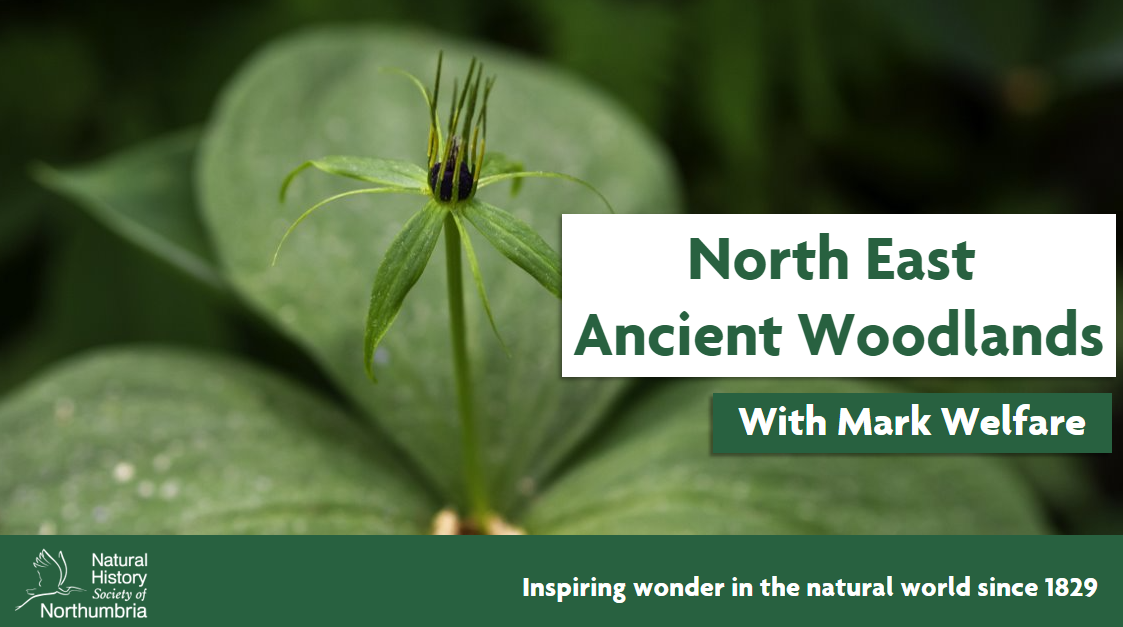Description
Join local naturalist, Mark Welfare, for an introductory look at the wildlife of the North East's ancient woodlands
Course tutor: Mark Welfare
Course length: Four sessions, March - May 2024.
Course structure: Please check the program below.
Course cost: £75 NHSN Members/£85 Non-Members
Outline
Northumbria’s ancient (or semi-ancient) woodlands are of great conservation value. In this new course, we will look at how the natural history of these woodlands has been influenced by humans and then share three targeted field trips looking for the typical plants that mostly flower in early spring before the leaves on the trees are fully out. We will learn which plants are indicators of Ancient woodlands. Spring is also the best time to find many species of mining bee (Andrena) and to hear the song of newly arrived migrant birds. We will also look at Natural England’s current survey of Ancient woodlands.
Who's it suitable for?
This course is suitable for both people at the start of their natural history journey and more experienced naturalists. It will interest those with a passion for plants, vertebrates and invertebrates as well as those who want to learn how they all function together in an ecosystem
Please read the terms and conditions for NHSN education courses before booking.
Recommended Equipment
We will use binoculars, botanist’s loupes and catch and release techniques for insects but we can arrange lend/share for most of these items. We will also look at the use of Apps to help identify birdsong, plants and insects as well as covering biological recording if people are interested in this.
Pace and terrain
The pace of the field trips will be quite slow, covering short to moderate walks (2-5km) with some hilly or irregular terrain to negotiate.
Programme of trips
Tuesday 26 March, 10 am-1 pm - Gosforth Nature Reserve
An introduction to this important habitat. We will cover questions such as ‘what defines an ancient woodland, where are they and why are they there, what are the principal species of trees, plants, invertebrates and vertebrates present? This session is mainly classroom based plus some time looking at winter tree characteristics and any early invertebrates which might be nectaring on the willows.
Tuesday 16 April, 10.30am - 2pm - Scotch Ghyll and Collingwood woods, Morpeth
Spring flowers and trees. Together, we'll look for scarce early spring plants such as Sweet Violet, Toothwort, Yellow Star-of-Bethlehem and Herb-Paris, amongst others with a small change of location at lunchtime.
Tuesday 14 May, 10.30am - 2.30pm - Briarwood Banks, Bardon Mill, Hexham
In this session, we'll explore spring flowers, trees and migrant birds such as the confusing Garden warbler and Blackcap, Pied Flycatcher and Redstart and invertebrates including up to 7 species of mining bees as well as hoverflies including the ramson-specialist Portevinia maculata and the woodland specialist Ferdinandea cuprea. We will also look at how geology and plantings have shaped the habitat that we see today including the small area of calaminarian grassland with its lead-tolerant plants. Plants we could find include Early Purple Orchid, Herb-Paris, Toothwort and Mountain Pansy.
Tuesday 11 June - TBA
Venue to be decided but likely the Wansbeck Valley. Mid-summer for the woodlands and a chance to catch up on some later flowering plants such as Giant Bellflower, Bird’s-nest Orchid and woodland grasses such as Wood Millet and Wood Meadow-grass. We'll also cover new insects and observe how there is a succession of plants growing through the season in the same place and look at potential threats to the survival of these woodlands such as drier hotter summers, excessive deer numbers and invasive plant species.
About the tutor
Mark is a recently retired medic who started birding in his teens and in the last 5 years has diversified to learn about plants, bees, hoverflies, Odonata, moths, and butterflies. A keen recorder he has more than 20,000 Northumberland records of 1000 species on iRecord and is a keen supporter of the NHSN citizen science projects. Having been a medical educator, he is keen on sharing his developing knowledge and inspiring others.
